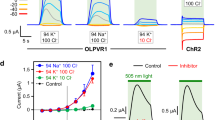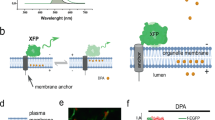Abstract
IT has been suggested that rhythmic oscillations in membranes are the underlying mechanism for endogenous circadian rhythms1,2 To support this suggestion, periodic oscillations in membranes of organisms displaying circadian rhythmicity must first be demonstrated. Rhythmic oscillations associated with membranes have been observed in the spontaneous firing of the optic nerve of Aplysia3 and in the transmembrane potential of the pulvini of Samanea4. It is not clear if these membrane-associated rhythms are a function of specialised cells, or are basic phenomena of circadian rhythms. The only membrane-associated rhythm described in a unicellular organism so far is that of a circadian rhythm in particle distribution of one of the membranes of Gonyaulax polyedra5. We have now investigated the rhythmic changes in the membrane potential of G. polyedra. We used the method of Hoffman and Laris6, in which fluorescent cyanine dyes are used to monitor the membrane potential in vivo of cells not amenable to the insertion of microelectrodes, in this case because of their small size and lack of a central vacuole. Our results suggest a temporal reorganisation of one of the membranes of Gonyaulax with circadian time.
This is a preview of subscription content, access via your institution
Access options
Subscribe to this journal
Receive 51 print issues and online access
$199.00 per year
only $3.90 per issue
Buy this article
- Purchase on Springer Link
- Instant access to full article PDF
Prices may be subject to local taxes which are calculated during checkout
Similar content being viewed by others
References
Sweeney, B. M., Int. J. Chronobiol., 2, 25–33 (1974).
Njus, D., Sulzman, F. M., and Hastings, J. W., Nature, 248, 116–120 (1974).
Jacklet, J. W., Science, 164, 562–563 (1969).
Racusen, R., and Satter, R. L., Nature, 255, 408–410 (1975).
Sweeney, B. M., Am. Inst. biol. Sci. meeting, 1975 (Abstr.).
Hoffman, J. F., and Laris, P. G., J. Physiol., Lond., 239, 519–552 (1974).
Guillard, R. R. L., and Ryther, J. H., Can. J. Microbiol., 8, 229–239 (1962).
Laris, P. C., Bahr, D. P., and Jaffee, R. R. J., Biochim. biophys. Acta, 376, 415–475 (1975).
Löeblich, A. R., III, Proc. N. Am. Paleontol. Convention, Part G, 867–929 (1969).
Adamich, M., and Sweeney, B. M., Planta (in the press).
Gaff, D. F., and OKong'O-Ogola, O., J. exp. Bot., 22, 756–758 (1971).
Stadleman, E. J., and Kinzel, H., in Methods in Cell Physiology (edit. by Prescott, D. M.), 325–372 (Academic, New York, 1972).
Laris, P. C., Pershadsingh, H. A., and Johnstone, R. M., J. gen. Physiol., 66, 14a (1975).
Sims, P. J., Waggoner, A. S., Wang, C. H., and Hoffman, J. F., Biochemistry, 13, 3315–3330 (1974).
Huebner, J. S., Biochim. biophys. Acta, 406, 178–186 (1975).
Sweeney, B. M., Pl. Physiol., Lancaster, 53, 337–342 (1974).
Lowry, O. H., Rosebrough, N. J., Farr, L. A., and Randall, R. J., J. biol. Chem., 193, 265–275 (1951).
Undenfriend, S., Stein, S., Böhlen, P., and Dairman, W., Science, 178, 871–872 (1972).
DeGier, J., Haest, C. W. M., Mandersloot, G., and Van Deenen, L. L. M., Biochem. biophys. Acta, 211, 373–375 (1970).
Van Deenen, L. L. M., Fedn Proc., 30, 1032 (1971).
Scarpa, A., and DeGier, J., Biochem. biophys. Acta, 241, 789–797 (1971).
DeGier, J., and Scarpa, A., Abstr. FEBS Meet., 520 (1971).
Korasne, S., Eisenman, G., and Szabo, G., Science, 174, 412–415 (1971).
Stark, G., Benz, R., Pohl, G. W., and Janko, K., Biochim. biophys. Acta, 266, 603–612 (1972).
Adamich, M., Sweeney, B. M., ICN-UCLA Winter Conf. molec. Cell Biol., No. 68, 42 (University of California, Los Angeles, 1976).
Stadelman, E. J., A. Rev. Pl. Physiol., 20, 585–606 (1969).
Author information
Authors and Affiliations
Rights and permissions
About this article
Cite this article
ADAMICH, M., LARIS, P. & SWEENEY, B. In vivo evidence for a circadian rhythm in membranes of Gonyaulax. Nature 261, 583–585 (1976). https://doi.org/10.1038/261583a0
Received:
Accepted:
Published:
Issue Date:
DOI: https://doi.org/10.1038/261583a0
This article is cited by
-
Diel periodicity in phytoplankton productivity
Hydrobiologia (1992)
-
Cyanine dye structural and voltage-induced variations in photo-voltages of bilayer membranes
The Journal of Membrane Biology (1978)
-
A quantitative resolution of the spectra of a membrane potential indicator, diS-C3-(5), bound to cell components and to red blood cells
The Journal of Membrane Biology (1978)
Comments
By submitting a comment you agree to abide by our Terms and Community Guidelines. If you find something abusive or that does not comply with our terms or guidelines please flag it as inappropriate.



